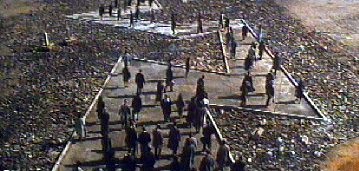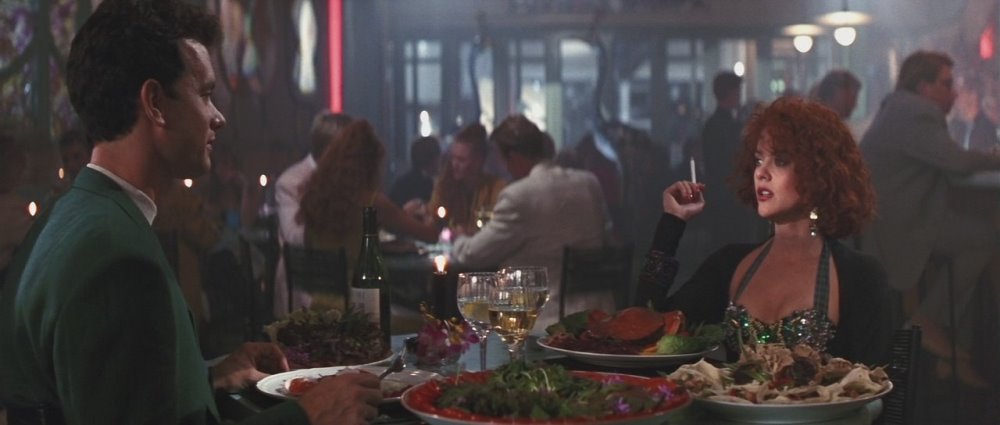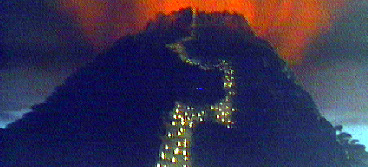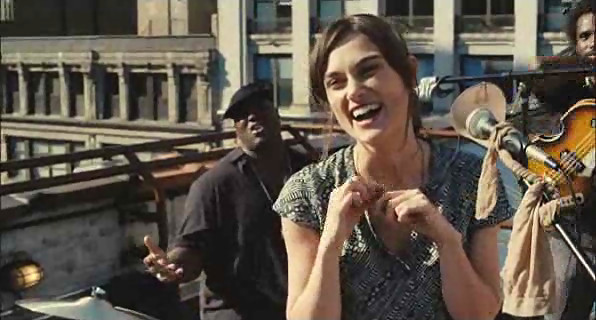
A review of Joe Versus the Volcano is very difficult to write. It is at once epic and intimate, ambitious and silly, humorous and melancholy, ridiculous and thought provoking. It is a movie that has a passionate fanbase, but a movie that has divided critics and audiences since it was released in 1990. On IMDb it has a user rating of only 5.7/10, on RottenTomatoes a "rotten" critics score of just 58% (and an audience score of 54%), a thumbs down from Gene Siskel, New York Times film critic Vincent Canby wrote "Not since Howard the Duck has there been a big-budget comedy with feet as flat as those of Joe Versus the Volcano. Many gifted people contributed to it, but there's no disbelieving the grim evidence on the screen." Yet it had some staunch defenders like Roger Ebert who called it "new and fresh and not shy of taking chances" upon its original release. Obviously, since I’m writing this review, I’m on the side that Ebert is on. This movie is full of life and invention, warmth, whimsy and insanity, and even Tom Hanks has referred to it as something of a Hidden Gem in his filmography.

Joe Versus the Volcano was written and directed by John Patrick Shanley, who was coming off his Oscar win for writing Moonstruck and making his directorial debut. He enlisted two key collaborators in cinematographer Stephen Goldbatt and production designer Bo Welch. Goldblatt had started as a photographer, taking many famous photos of The Beatles during the White Album years. He’d also just come off shooting the first two Lethal Weapon movies and would go on to be the DP of choice for Mike Nichols at the end of his career. Bo Welch had made a name for himself working for Tim Burton, so this was just coming after his extraordinary work in Beetlejuice. These three worked together to create a movie of distinct visual invention and thematic relevancy, as there are production elements tying things together throughout the movie in a way that you rarely see.

We begin with the classic “Once upon a time” but continue with “there was a man named Joe who had a boring job” and we watch Joe Banks (Hanks) sulk into work at the American Panascope Corporation (home of the Rectal Probe!) where he works in the advertising library. He walks pathetically into the building alongside innumerable fellow zombies going to work at this place that looks like it would steal your life away. It’s doing exactly that as we hear Eric Burden’s version of “16 Tons” on the soundtrack “Sold my soul to the company store”. Joe pines after Dede (Meg Ryan) who works in the office as well. We find out that Joe is a hypochondriac who gets berated by his boss (Dan Hedaya) for needing to take off again for yet another doctor’s appointment. But when Joe sees the doctor (Robert Stack), he’s told he has a very rare condition known as a brain cloud, which was only discovered by Joe’s insistence on doing a barrage of tests. Joe’s given only about 6 months to live, and rather than view this as a death sentence, he’s awoken from the slumber in which he’d been living his life for so long.

Joe asks out Dede, and is later approached by a wacky billionaire named Samuel Graynamore (a wild eyed and hilarious Lloyd Bridges) who wants to hire Joe to help him out. A tiny Pacific island called Waponi Woo has a rare mineral deposit that the islanders won’t give Graynamore access to mine for his business unless he gets someone to act as human sacrifice to the fire god by jumping into the island’s volcano. Since Joe is going to die anyway, why not have him do it, right? Graynamore will give Joe a ton of money to live like a king until that fateful day. He even has one of his daughters, Angelica (also played by Meg Ryan) pick him up at the airport in LA, before his other daughter Patricia (also also played by Meg Ryan) sails Joe to the island.

There are plenty of side characters Joe meets along the way, including a philosophical limo driver played by Ossie Davis, and the island chief played with hilarious understatement by Abe Vigoda. But one of the things that makes this movie work, and I think something that turns people off, is that these people don’t quite act or talk like movie characters, and especially not like real people. They speak in dialog that’s subtly stylized, sometimes using odd words, or just saying things in a way that doesn’t sound like everyday speech. To the movie’s fans, this is all part of the fairy tale ride you join the movie on. Anjelica referring to herself as a flibbertigibbet is funny in its use of an almost archaic word that nobody actually uses anymore. I’m sure the detractors look at it as annoying or pretentious or any other negative thing, but this movie has whimsy and also a sense of heart that really connects with me. I’ve not heard him talk about it as an influence, but this feels like a Wes Anderson movie, but made when Anderson was still in college.

The recurring motifs in the movie help tie things together even though it’s really an episodic journey. The distinct lightning bolt pattern, which is the shape of the walkway into Joe’s work, as well as a crack in his wall, the shape of an actual lightning bolt that sinks a boat, and ultimately the shape of the walkway up the volcano. Joe refers to the crooked road we all have to travel, and this subtle visual repetition helps underscore that. Again, it’s to the credit of Shanley and Welch’s planned production design that they were able to pull this off visually. Shanley has said the movie was meticulously storyboarded, with his goal that even though there’s not a ton of camera movement the frame will be beautifully packed to the brim with many interesting pieces. There are things in the script like that as well, such as the three books Joe has in his office being Romeo and Juliet, Robinson Crusoe, and The Odyssey, all of which inform his journey.

But still, a movie must grab us with its story. Like the movie as a whole, Joe’s story is a mashup of a lot of things. It’s part the classic heroes courageous journey, part romantic comedy, part lonely character study, and part self-help style “waking up and appreciating life” kinda story. Joe faces his imminent death by embracing life. Ryan’s Patricia, as she and Joe are falling in love, tells Joe “My father says that almost the whole world is asleep. Everybody you know. Everybody you see. Everybody you talk to. He says that only a few people are awake, and they live in a state of constant, total amazement.” And that’s Joe. Once asleep like the rest of the masses, now awake and in awe of what he finds. In the movie’s most beautiful and transcendent moment, as Joe and Patricia are floating in the ocean, Joe, battered, sun baked, and weakened by dehydration, looks over the horizon at the giant rising moon. He’s been on his journey of appreciating life again and almost begs to the moon, prays to it, “Dear God, whose name I do not know,” his arms outstretched in an almost religious surrender, “Thank you for my life. I forgot how big... thank you. Thank you for my life.”

Now that I think about it, this would make a great double feature with Albert Brooks' Defending Your Life. Both are about not letting fear rule your life. About how you need to follow your desires and only then can you achieve something worth achieving. Only by being true to yourself can you get to somewhere bigger than yourself. Both skirt around religion by not mentioning it, but tackling the themes and elements at religion’s core. Both are also, of course, brilliant and funny and thought provoking and we’d be much better off if everyone saw them. If I owned a theater, this would totally be a double feature I’d set up.

I believe I saw the movie opening weekend, for my brother's 10th birthday. Of course I would’ve only been 7 at the time, so I didn’t really appreciate the movie. Two things that stuck out in my memory as things I liked, Joe catching a hammerhead shark while fishing and the island people’s love of orange soda, now are among the things I’m not sure quite work, at least not as well as the rest of the movie. Still, this movie is so singular that I agree with Ebert saying "Gradually during the opening scenes of Joe Versus the Volcano my heart began to quicken, until finally I realized a wondrous thing: I had not seen this movie before. Most movies, I have seen before. Most movies, you have seen before. Most movies are constructed out of bits and pieces of other movies, like little engines built from cinematic Erector sets. But not Joe Versus the Volcano." He later added “I continue to believe it deserves greater recognition, and cannot understand why I gave it 3.5 stars instead of four.” It’s a movie that deserves to be seen by more people. And even if you saw it when it came out, time is often kind to movies that try to be different than everything else. I believe time has been kind and will continue to be kind to Joe Versus the Volcano.




